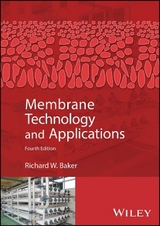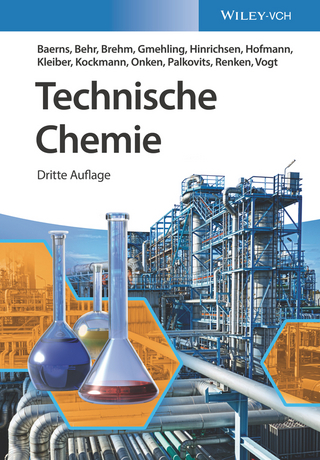
Membrane Technology and Applications
John Wiley & Sons Inc (Verlag)
978-0-470-74372-0 (ISBN)
- Titel erscheint in neuer Auflage
- Artikel merken
“… the best handbook on membrane technology, which is currently on the market... ” –Membrane News (on the previous edition)
Building on the success of the previous edition, Membrane Technology and Applications Third Edition provides a comprehensive overview of separation membranes, their manufacture and their applications. Beginning with a series of general chapters on membrane preparation, transport theory and concentration polarization, the book then surveys several major areas of membrane application in separate chapters. Written in a readily accessible style, each chapter covers its membrane subject thoroughly, from historical and theoretical backgrounds through to current and potential applications. Topics include reverse osmosis, ultrafiltration, pervaporation, microfiltration, gas separation and coupled and facilitated transport; chapters on electrodialysis and medical applications round out the coverage.
NEW TO THE THIRD EDITION
New sections on the use of membranes in the chlor-alkali industry, membrane distillation, pressure retarded osmosis and constant flux-variable pressure ultrafiltration
Zeolite and ceramic membranes, submerged membrane modules, and fuel cell membranes
Substantially enhanced chapters on ultrafiltration, pervaporation and membrane contactors
Updates to every chapter to reflect the developments in the field
Richard W. Baker, Membrane Technology and Research, Inc.(MTR), Newark, California, USA
Preface xi
Acknowledgments xiii
1. Overview of Membrane Science and Technology 1
1.1 Introduction 1
1.2 Historical Development of Membranes 1
1.3 Types of Membranes 4
1.3.1 Isotropic Membranes 4
1.3.2 Anisotropic Membranes 6
1.3.3 Ceramic, Metal, and Liquid Membranes 6
1.4 Membrane Processes 6
References 13
2. Membrane Transport Theory 15
2.1 Introduction 15
2.2 The Solution-Diffusion Model 18
2.2.1 Molecular Dynamics Simulations 18
2.2.2 Concentration and Pressure Gradients in Membranes 22
2.2.3 Application of the Solution-Diffusion Model to Specific Processes 27
2.2.4 A Unified View 50
2.3 Structure-Permeability Relationships in Solution-Diffusion Membranes 53
2.3.1 Diffusion Coefficients 55
2.3.2 Sorption Coefficients in Polymers 64
2.4 Pore-Flow Membranes 72
2.4.1 Permeation in Ultrafiltration and Microfiltration Membranes 73
2.4.2 Knudsen Diffusion and Surface Diffusion in Microporous Membranes 79
2.4.3 Polymers with Intrinsic Microporosity (PIMs) 86
2.4.4 The Transition Region 89
2.5 Conclusions and Future Directions 90
References 92
3. Membranes and Modules 97
3.1 Introduction 97
3.2 Isotropic Membranes 98
3.2.1 Isotropic Nonporous Membranes 98
3.2.2 Isotropic Microporous Membranes 100
3.3 Anisotropic Membranes 102
3.3.1 Phase separation membranes 104
3.3.2 Interfacial Polymerization Membranes 121
3.3.3 Solution-Coated Composite Membranes 125
3.3.4 Other Anisotropic Membranes 128
3.3.5 Repairing Membrane Defects 132
3.4 Metal, Ceramic, Zeolite, Carbon, and Glass Membranes 134
3.4.1 Metal Membranes 134
3.4.2 Ceramic Membranes 135
3.4.3 Zeolite Membranes 139
3.4.4 Mixed-Matrix Membranes 141
3.4.5 Carbon Membranes 145
3.4.6 Microporous Glass Membranes 148
3.5 Liquid Membranes 148
3.6 Hollow Fiber Membranes 148
3.7 Membrane Modules 154
3.7.1 Plate-and-Frame Modules 155
3.7.2 Tubular Modules 157
3.7.3 Spiral-Wound Modules 158
3.7.4 Hollow Fiber Modules 162
3.7.5 Other Module Types 165
3.8 Module Selection 167
3.9 Conclusions and Future Directions 169
References 170
4. Concentration Polarization 179
4.1 Introduction 179
4.2 Boundary Layer Film Model 182
4.3 Determination of the Peclet Number 191
4.4 Concentration Polarization in Liquid Separation Processes 193
4.5 Concentration Polarization in Gas Separation Processes 196
4.6 Cross-Flow, Co-Flow, and Counter-Flow 197
4.7 Conclusions and Future Directions 204
References 205
5. Reverse Osmosis 207
5.1 Introduction and History 207
5.2 Theoretical Background 208
5.3 Membranes and Materials 213
5.3.1 Cellulosic Membranes 213
5.3.2 Noncellulosic Polymer Membranes 216
5.3.3 Interfacial Composite Membranes 217
5.3.4 Other Membrane Materials 219
5.4 Reverse Osmosis Membrane Categories 220
5.4.1 Seawater and Brackish Water Desalination Membranes 221
5.4.2 Nanofiltration Membranes 222
5.4.3 Hyperfiltration Organic Solvent Separating Membranes 224
5.5 Membrane Selectivity 227
5.6 Membrane Modules 228
5.7 Membrane Fouling Control 231
5.7.1 Scale 231
5.7.2 Silt 233
5.7.3 Biofouling 233
5.7.4 Organic Fouling 235
5.7.5 Membrane Cleaning 236
5.8 Applications 237
5.8.1 Brackish Water Desalination 238
5.8.2 Seawater Desalination 240
5.8.3 Ultrapure Water 241
5.8.4 Wastewater Treatment 242
5.8.5 Nanofiltration 244
5.8.6 Organic Solvent Separation 245
5.9 Conclusions and Future Directions 246
References 247
6. Ultrafiltration 253
6.1 Introduction and History 253
6.2 Characterization of Ultrafiltration Membranes 254
6.3 Membrane Fouling 257
6.3.1 Constant Pressure/Constant Flux Operation 257
6.3.2 Concentration Polarization 261
6.3.3 Fouling Control 271
6.4 Membranes 274
6.5 Constant Pressure Modules, System Design, and Applications 274
6.5.1 Cross-Flow Ultrafiltration Modules 275
6.5.2 Constant Pressure (Cross-Flow) System Design 278
6.5.3 Applications of Cross-Flow Membrane Modules 282
6.6 Constant Flux Modules, System Design, and Applications 292
6.6.1 Constant Flux/Variable Pressure Modules 292
6.6.2 Submerged Membrane Modules and System Design 293
6.6.3 Submerged Membrane Applications 296
6.7 Conclusions and Future Directions 299
References 300
7. Microfiltration 303
7.1 Introduction and History 303
7.2 Background 305
7.2.1 Types of Membrane 305
7.2.2 Membrane Characterization 306
7.2.3 Microfiltration Membranes and Modules 313
7.2.4 Process Design 316
7.3 Applications 320
7.3.1 Sterile Filtration of Pharmaceuticals 322
7.3.2 Sterilization of Wine and Beer 322
7.3.3 Microfiltration in the Electronics Industry 323
7.4 Conclusions and Future Directions 323
References 324
8. Gas Separation 325
8.1 Introduction and History 325
8.2 Theoretical Background 326
8.2.1 Polymer Membranes 328
8.2.2 Metal Membranes 337
8.2.3 Ceramic and Zeolite Membranes 337
8.2.4 Thermally Rearranged/Microporous Carbon Membranes 338
8.2.5 Mixed-Matrix Membranes 338
8.3 Membrane Modules 338
8.4 Process Design 339
8.4.1 Pressure Ratio 340
8.4.2 Stage-Cut 343
8.4.3 Multistep and Multistage System Designs 345
8.4.4 Recycle Designs 347
8.5 Applications 349
8.5.1 Hydrogen Separations 350
8.5.2 Oxygen/Nitrogen Separation 352
8.5.3 Natural Gas Separations 359
8.5.4 Carbon Dioxide Separation 361
8.5.5 Vapor/Gas Separations 368
8.5.6 Dehydration of Air 369
8.5.7 Carbon Dioxide/Hydrogen and Carbon Dioxide/Nitrogen Separations 370
8.5.8 Vapor/Vapor Separations 372
8.6 Conclusions and Future Directions 373
References 375
9. Pervaporation 379
9.1 Introduction and History 379
9.2 Theoretical Background 381
9.3 Membrane Materials and Modules 389
9.3.1 Membrane Materials 389
9.3.2 Dehydration Membranes 392
9.3.3 Organic/Water Separation Membranes 393
9.3.4 Organic/Organic Separation Membranes 394
9.3.5 Membrane Modules 395
9.4 System Design 398
9.5 Applications 400
9.5.1 Solvent Dehydration 401
9.5.2 Separation of Dissolved Organics from Water 406
9.5.3 Separation of Organic Mixtures 409
9.6 Conclusions and Future Directions 412
References 412
10. Ion Exchange Membrane Processes – Electrodialysis 417
10.1 Introduction/History 417
10.2 Theoretical Background 421
10.2.1 Transport through Ion Exchange Membranes 421
10.3 Chemistry of Ion Exchange Membranes 423
10.3.1 Homogeneous Membranes 425
10.3.2 Heterogeneous Membranes 426
10.4 Electrodialysis 428
10.4.1 Concentration Polarization and Limiting Current Density 428
10.4.2 Current Efficiency and Power Consumption 433
10.4.3 System Design 435
10.5 Electrodialysis Applications 438
10.5.1 Brackish Water Desalination 438
10.5.2 Salt Recovery from Seawater 438
10.5.3 Other Electrodialysis Separation Applications 440
10.5.4 Continuous Electrodeionization and Ultrapure Water 442
10.5.5 Bipolar Membranes 443
10.6 Fuel Cells 444
10.7 Membranes in Chlor-Alkali Processes 448
10.8 Conclusions and Future Directions 449
References 449
11. Carrier Facilitated Transport 453
11.1 Introduction/History 453
11.2 Coupled Transport 459
11.2.1 Background 459
11.2.2 Characteristics of Coupled Transport Membranes 463
11.2.3 Coupled Transport Membranes 468
11.2.4 Applications 472
11.3 Facilitated Transport 473
11.3.1 Background 473
11.3.2 Process Designs 476
11.3.3 Applications 481
11.4 Conclusions and Future Directions 486
References 487
12. Medical Applications of Membranes 493
12.1 Introduction 493
12.2 Hemodialysis 493
12.3 Blood Oxygenators 498
12.4 Plasma Fractionation 500
12.5 Controlled Drug Delivery 501
12.5.1 Membrane Diffusion-Controlled Systems 502
12.5.2 Biodegradable Systems 510
12.5.3 Osmotic Systems 512
References 518
13. Other Membrane Processes 521
13.1 Introduction 521
13.2 Dialysis 521
13.3 Donnan Dialysis (Diffusion Dialysis) 522
13.4 Charge Mosaic Membranes and Piezodialysis 526
13.5 Membrane Contactors and Membrane Distillation 529
13.5.1 Applications of Membrane Contactors 532
13.6 Membrane Reactors 538
13.6.1 Applications of Membrane Reactors 541
13.7 Ion-Conducting Membrane Reactors 544
13.8 Pressure-Retarded Osmosis (PRO) and Reverse Electrodialysis (RED) 547
13.9 Chiral Drug Separation 551
13.10 Conclusions and Future Directions 552
References 553
Appendix 559
Index 571
| Erscheint lt. Verlag | 1.10.2012 |
|---|---|
| Verlagsort | New York |
| Sprache | englisch |
| Maße | 168 x 239 mm |
| Gewicht | 1134 g |
| Themenwelt | Naturwissenschaften ► Chemie ► Technische Chemie |
| Technik ► Maschinenbau | |
| ISBN-10 | 0-470-74372-7 / 0470743727 |
| ISBN-13 | 978-0-470-74372-0 / 9780470743720 |
| Zustand | Neuware |
| Informationen gemäß Produktsicherheitsverordnung (GPSR) | |
| Haben Sie eine Frage zum Produkt? |
aus dem Bereich



